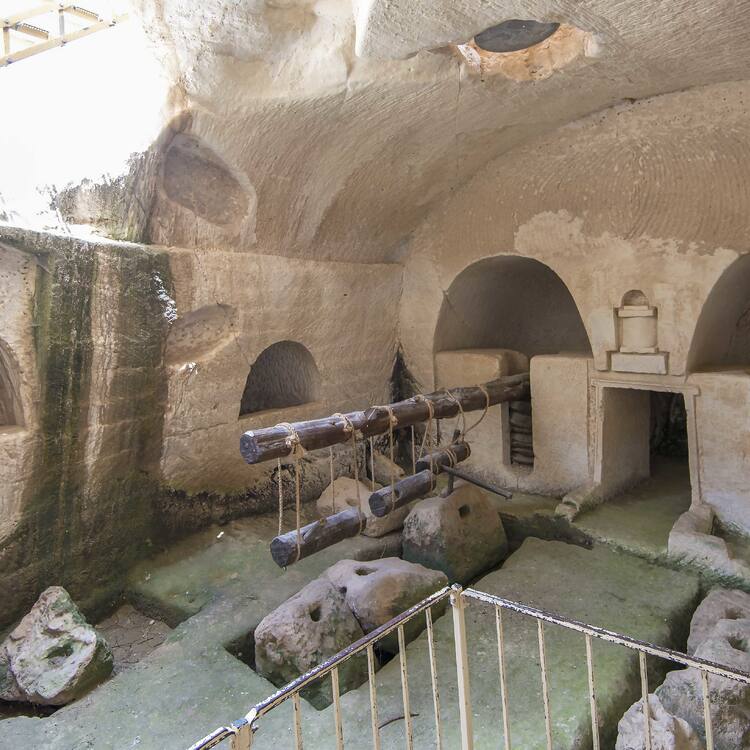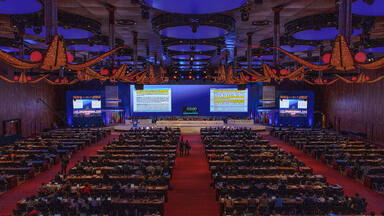Caves of Maresha and Bet-Guvrin in the Judean Lowlands as a Microcosm of the Land of the Caves
Caves of Maresha and Bet-Guvrin in the Judean Lowlands as a Microcosm of the Land of the Caves
The archaeological site contains some 3,500 underground chambers distributed among distinct complexes carved in the thick and homogenous soft chalk of Lower Judea under the former towns of Maresha and Bet Guvrin. Situated on the crossroads of trade routes to Mesopotamia and Egypt, the site bears witness to the region’s tapestry of cultures and their evolution over more than 2,000 years from the 8th century BCE—when Maresha, the older of the two towns was built—to the time of the Crusaders. These quarried caves served as cisterns, oil presses, baths, columbaria (dovecotes), stables, places of religious worship, hideaways and, on the outskirts of the towns, burial areas. Some of the larger chambers feature vaulted arches and supporting pillars.
Description is available under license CC-BY-SA IGO 3.0
Les grottes de Maresha et de Bet-Guvrin en basse Judée, un microcosme du pays des grottes
Le site archéologique comprend quelque 3500 chambres souterraines réparties en districts distincts creusés dans un sous-sol de calcaire crayeux épais et homogène en Basse Judée, sous les anciennes villes de Maresha et Bet Guvrin. Situé au carrefour des routes de commerce de Mésopotamie et d’Egypte, le site témoigne de la mosaïque de cultures de la région et de leur évolution sur plus de 2000 ans, du 8è siècle av. J.C., lorsque Maresha – la plus ancienne des deux villes – fut construite, jusqu’à l’époque des Croisés. Ces caves servaient de citernes, de moulin à huile, de bains, de colombiers, d’étable, de lieux de culte, d’abris pour les périodes de troubles et, à la périphérie des villes, de zones funéraires. Certaines des chambres les plus vastes présentent des voutes en arche et leur piliers de soutènement.
Description is available under license CC-BY-SA IGO 3.0
Пещеры Мареши и Бейт Гуврина в Иудейской долине как микрокосм Земли пещер
Объект, получивший название «город под городом», представляет собой комплекс искусственных пещер, расположенных в Нижней Иудее под древними городами-побратимами Мареша и Бейт Гуврин. Они вырыты в толстом однородном слое мягкого известняка. Комплекс включает как отдельно расположенные пещеры, так и сети пещер различных форм и назначений, свидетельствуя о том, что пещеры создавались и использовались на протяжении более 2 тысяч лет, с начала железного века до крестовых походов, а также о большом разнообразии методов подземного строительства. Изначально пещеры предназначались для добычи камня, однако позднее они были преобразованы и использовались для различных сельскохозяйственных и ремесленных целей, в том числе в качестве маслодавильных цехов, голубятен, конюшен, подземных цистерн и водоводов, бань, мест захоронения, отправления культа, а также в качестве укрытий в неспокойные времена.
source: UNESCO/CPE
Description is available under license CC-BY-SA IGO 3.0
Cuevas de Maresha y Bet Guvrin en la Baja Judea – Microcosmos de la Tierra de las Cuevas
El sitio arqueológico comprende unas 3.500 cámaras subterráneas repartidas en distritos distintos excavados en un subsuelo de caliza blanda espeso y homogéneo en la Baja Judea, bajo las antiguas ciudades de Maresha y Bet Guvrin. Situado en la encrucijada de las rutas de comercio de Mesopotamia y Egipto, el sitio atestigua del mosaico de culturas de la región y su evolución a lo largo de más de 2.000 años, desde el siglo VIII a. de C., cuando se construyó Maresha, hasta la época de las Cruzadas. Estas cuevas servían como cisternas, almazaras, baños, palomares, establos, lugares de culto y escondites para los tiempos turbulentos y, en la periferia de las ciudades, como zonas funerarias. Algunas de las cámaras más vastas presentan bóvedas con arcos y pilares para sujetarlas.
source: UNESCO/CPE
Description is available under license CC-BY-SA IGO 3.0
洞窟の地の小宇宙としてのユダヤ低地のマレシャとベイト・グブリンの洞窟群
source: NFUAJ
Grotten van Maresha en Bet Guvrin in het Judese Laagland als microkosmos van het Land van de Grotten
Source: unesco.nl
Outstanding Universal Value
Brief synthesis
The presence in the Judean Lowlands of thick and homogeneous chalk sub-strata enabled numerous caves to be excavated and managed by Man. The property includes a very complete selection of chambers and man-made subterranean networks, of different forms and for different activities. They are situated underneath the ancient twin cities of Maresha and Bet Guvrin, and in the surrounding areas, constituting a “city under a city”. They bear witness to a succession of historic periods of excavation and use, over a period of 2,000 years. Initially the excavations were quarries, but they were later converted for various agricultural and local craft industry purposes, including oil presses, columbaria, stables, underground cisterns and channels, baths, tombs and places of worship, and hiding places during troubled times, etc. With their density, diversified activities, use over two millennia and the quality of their state of preservation, the complexes attain an Outstanding Universal Value.
Criterion (v): The underground archaeological site of Maresha–Bet Guvrin is an eminent example of traditional use of chalk subsurface strata, with the development of man-made caves and networks conducive to multiple economic, social and symbolic purposes, from the Iron Age to the Crusades.
Integrity
The integrity of the property is expressed in the first place by the diversity of the excavations and their arrangements, intended for a variety of economic, social, funerary and symbolic purposes. It is also expressed by the exceptional density of the subterranean structures which are found beneath the ancient twin cities of Maresha and Bet Guvrin. The integrity of the property also concerns its relations with the outside and the preservation of a landscape of ancient ruins in a well-preserved environment of Mediterranean vegetation.
Authenticity
The underground structures of Maresha–Bet Guvrin are authentic. They have been well-preserved, firstly because of the quality of their architectural design at the time of their excavation, then by their maintenance over a long period of use, and finally by a prolonged period of abandonment, filling up naturally over time, which has contributed to their preservation. This authenticity is however relatively fragile, with the risk of infiltrations of water leading to possible collapse of the vaults. It will furthermore be necessary to pursue a policy of low-key restoration, avoiding possible over-interpretation with reconstruction, and ensuring that the necessary technical consolidations are carried out in a way which respects the authenticity perceived by the visitor.
Protection and management requirements
The management system of the Maresha-Bet Guvrin National Archaeological Park has been in place now for many years and functions efficiently. It is supervised by the Israel Nature and Parks Authority (INPA) and benefits from the Authority’s system of protection, which also covers most of the buffer zone. The regulations concerning this zone are completed by a National Forestry Plan and directives on the limitation of size and height of possible surrounding constructions. The conservation of cultural elements is guaranteed by the Israel Antiquities Authority (IAA), and benefits from specialist assistance for highly technical issues such as the monitoring of the rocks forming the walls and vaults of the threatened caves. The tourism development project is based on a long-standing tradition and is well managed.


